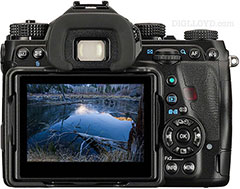Pentax K1: Impressive Innovation Unmatched by CaNikon
See my Pentax K1 wish list at B&H Photo.
See other Pentax K1 discussions.
Why am I writing this and the other posts, and spending so much effort on what so far has been (at best) an also-ran camera system? Because I’ve now gone through the Pentax K1 online material, and it is impressive: I don’t think that any DSLR has ever piqued my interest this strongly, particularly its impressive image quality, though lens selection concerns me.
Pentax really thinks about making cameras more useful and useable for real world shooting challenges. CaNikon really are not delivering even a fraction of what the innovation Pentax is delivering in the K1. If CaNikon (and Sony too) implemented all the good ideas that Pentax is bringing to the table, more terrific things would emerge, and the industry would leap forward via competition. It might even rejuvenate the camera market. So I think it’s worth the trouble to go into the K1 in some detail.
Below, I discuss particular features in the Pentax K1 that most impress me. I plan to explore these features when I review the Pentax K1—does the implementation hold up in the field, and are there operational or design flaws that intrude?
My sense is that if these Pentax K1 features deliver the goods (particularly SuperResolution pixel shift mode), them the K1 may well be a must-have camera for some pro shooters, if only for certain types of jobs where ultra-high quality is desired. Certainly it seems to be an outstanding candidate for product photography (there are three Pentax K-mount Schneider tilt/shift lenses for it of 28mm, 50mm, 90mm focal lengths).
In addition to the items called out in detail below, there is an incredible feature set:
- Built-in lighting for night operation. Over the years, I learned to carry a flashlight to see camera buttons. This is insanely great thinking in paying attention to usability details.
- A button that can cycle between five brightness settings for the rear LCD—so one can quickly dim the screen (dusk or dark), brighten it (sunlight), etc. A simple thing but very thoughtful.
- Dustproof and weatherproof construction, dust removal system for sensor, 300,000 exposure duty cycle for shutter, magnesium alloy body.
- A rear LCD that tilts along the optical axis.
- Auto horizon leveling handheld up to 2° using the sensor! Composition adjustment too.
- Built-in GPS + compass and even a GPS logging feature, along with star tracking for sharp stars during long exposures.
- Built-in WiFi with control possible via a smartphone.
- 4K time lapse movies (hooray!), though only 1080p for video.
- A lock button to lock controls and dual SD card slots.
- Nearly 100% viewfinder coverage with “floating mirror” yet in a compact form factor.
- One button press to set manual exposure settings to program-mode values, along with AE lock.
- Skin-tone correction, digital filters, in-camera raw development to JPEG or TIFF.
Pixel shift for true-color pixels and higher resolution
Read my initial impressions of SuperResolution pixel shift mode.
Although the Pentax K1 also has an anti-aliasing filter simulator, the pixel shift feature makes it largely irrelevant, since troublesome color moiré and demosaicing artifacts do not occur with true-color pixels of SuperRes mode.
With true-color pixels, certain types of moiré and color aliasing are eliminated, “zipper” lines on diagonals go away, demosaicing spurious resolution disappears, etc. Instead, each pixel stands on its own, which in my estimation yields around 50% to as much as 100% gain in pixel equivalence (in terms of equivalent to conventional sensors). Bottom line: the 36MP K1 sensor in SuperResolution mode seemingly has the potential to rival medium format, indeed to surpass it. Plus, a SuperResolution mode ought to deliver amazing potential for black and white imagery.
I intend to explore SuperResolution mode in detail, including just how much of an issue subject movement is in practice, particularly with moving water, wind on grass or leaves, etc.
Built in rise and fall and shift
Pentax calls this Composition Adjustment. Using the anti-shake mechanism, the sensor can be moved up or down (rise and fall) or left or right (shift). While the amount of movement is limited to only 1.5mm, this can be quite helpful with a wide angle lens or with closeups. See page 61 of the Pentax K3 II user manual for how the K3 II works; the K1 presumably is similar. In theory, if there is 3mm of range (1.5mm up and 1.5mm down), it should be possible to make 36 X 27mm images with no parallax issues (or 39 X 24mm images), Odd that Pentax doesn’t automate this, stitching the images automatically into one raw file, ideally also in SuperResolution mode.
In Body Stabilization for all lenses
The Pentax K1 is not the first camera on the market with an in-body image stabilized sensor, but it appears to offer the most sophisticated functionality.
Note only does the K1 reduce shake of five kinds, it can track stars blur-free using its built-in GPS, it can level the sensor (level horizon handheld!), and of course SuperResolution pixel shift mode.

HDR mode and translucent multiple exposure mode
As far as I know, Pentax is the only DSLR or mirrorless camera vendor to deliver multiple exposure HDR images in raw format; everyone else does JPEG only (it’s self defeating to do HDR in 8 bit, assuming you want something of quality that can be processed in post).
Pentax saves the multiple exposures in a single DNG or PEF raw file. The cool thing is you can shoot HDR and later decide against it, if desiring to use just one particular exposure. Not only that, but there is an Auto Align feature for shooting HDR handheld. Unfortunately, SuperResolution mode cannot be combined with HDR mode (according to page 87 of the Pentax K3 II user manual).
The multiple exposure mode is really cool: it shows you the image so far overlaid on the current Live View image. Wow! Presumably this is in raw format also, though it does not say here.

Diffraction compensation
I constantly use diffraction mitigating sharpening in my work that I publish. Diffraction robs images of “bite”, starting at f/8 for a 36MP sensor, becoming noticeably dull at f/11, with f/16 seriously degraded and f/22 a disaster.
If this feature applies to raw files and SuperResolution mode and it is well done, then it is awesome indeed. But page 60 of the Pentax K3 II user manual implies that it won’t affect raw, so it seems doubtful that the K1 will apply corrections to the raw file:
When[FileFormat] is set to[RAW],correction information is saved as a RAW file parameter and you can select whether to apply the correction to the images when developing them.
The issue is being forced out of a favored workflow (ACR or Lightroom) and having to use a specialty raw converter. Maybe ACR will support this?

Lens aberration correction + motion correction
Other vendors have lens corrections in various forms so it’s not an innovation per se, but with motion correction and diffraction correction it is indeed innovative.
According to page 60 of the Pentax K3 II user manual (K1 presumably the same), the corrections are not baked into the raw file image data. This is good and not good (potentially): does Adobe Camera Raw / Lightroom support the corrections? Being forced out of a favored workflow (ACR or Lightroom) and having to use a specialty raw converter is not appealing.
When[FileFormat]is set to[RAW] or [RAW+], correction information is saved as a RAW file parameter and you can select whether to apply the correction to the images when developing them. For the RAW Development function, [Color Fringe Correction] can also be set. (p.76)
...
When shooting an image with the Pixel Shift Resolution System, the K-1 provides a new Motion Correction function. When this function is activated, the camera automatically detects the amount of subject motion during continuous shooting and minimizes negative effects during the synthesizing process.

Image quality
Normally I would pay no attention at all to claims about image quality, the type of processor, etc since these under-the-hood things add up to image quality—just not interesting on their own.
But given the impressive image quality of the Pentax 645Z (probably even a little better than the Nikon D810) and given the Pentax K1 SuperResolution mode, I have to wonder if the K1 might not only offer superior image quality to all other DSLRs and mirrorless, but possibly even match or beat the 645Z (when using SuperResolution mode)?



























